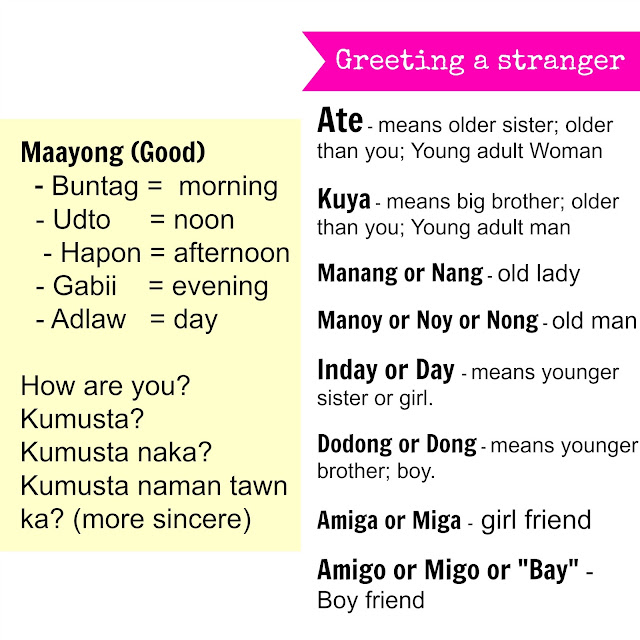Hi Amiga/ Amigo, today we are going to listen to a conversation of two people - the driver and passenger. Yes, we are going to ride a Taxi going to Ayala.
Ayala is a popular place here in Cebu. Most taxi drivers would ask where you want to alight in Ayala because it is a big place where the Cebu Business Park and the Ayala Center Mall are located. There are a lot of businesses in this area so you better be specific when you say "Ayala".
Let's hear the conversation.
Let's break down each phrases.
Driver: Maayong buntag Ma'am, asa ta?
"Good Morning, Ma'am. Where to?
In the phrase above, the driver greeted his passenger good morning. Maayong buntag is good morning.
Usually, Ma'am or Sir are commonly used to address a customer or client or when you are in a business setting.
Then, the driver said "asa ta?" which means "where should we go?" or "where to?"
Woman passenger: Maayong buntag sad, Kuya. Adto ta sa Ayala.
"Good morning to you too, Kuya. Let's go to Ayala."
Kuya is a common name used by Filipinos to address a man who's older which means "big brother".
In this phrase, the woman greeted back by saying, "maayong buntag sad, Kuya"
"sad" is "also/too" in English. This simple word means "good morning to you too, Big brother".
Then she answered to big brother "adto ta sa Ayala"
"Adto" is "to go".
"Adto ta" is "let's go"
"sa" is "going where"
Just fill in the blank...
Adto ta sa __________.
Or the simplest way to inform the driver where you want to go is to tell them the place directly.
For example,
Ayala ta, Kuya
Airport ta, Kuya
Fill in the black.
______ ta, Kuya.
The phrase "adto ta sa, Ayala" simply means "let's go to Ayala."
Driver: Asa ka dapita mo naug sa Ayala Ma'am.
"Where in Ayala would you like to alight, Ma'am"
In this phrase the driver was asking the lady where exactly in Ayala she will alight.
Asa is where.
ka is you
dapita - talking about location
naug- alight/ come down
Ayala - name of a place
Woman: Sa may terminal entrance ta, Kuya.
"at terminal entrance, Kuya"
The woman told the driver that she will alight at terminal entrance.
Sa may - at
ta - from the word "kita" means we
Driver: Ma'am mao na ni ang terminal entrance sa Ayala
"Ma'am, this is the terminal entrance of Ayala"
Mao na ni - means this is it
ang - the
sa - of
Woman: Kuya, pila?
"Kuya, how much?"
In this phrase, the woman is asking how much she needs to pay the driver
"pila" means "how much"
Driver: saisentay-otso, Ma'am.
"P68, Ma'am"
The driver answered P68.00 (sixty-eight pesos)
Saisenta - 60
otso - 8
Woman: Okay, Kuya. Dia ra ang bayad, Kuya
"okay, Kuya. Here's my fare, Kuya."
Dia ra - means "here it is"
ang - the
bayad - payment
So, this simply means "here's my payment". The payment refers to the taxi fare. To be exact, you can say "dia ra ang akong plete, kuya" which means "here's my fare."
Driver: Ma'am, sukli diay nimo.
"Ma'am, here's your change."
In this phrase, the driver wanted to give the change to the woman. Definitely, the woman gives more than P68.00.
Sukli - change
nimo - yours
diay - an expression that means "how about", "really", "indeed" depends on the situation. This is used also to give more emphasis to what you are saying. In this phrase, you can omit "diay".
Woman: oi, daghan salamat, Kuya.
"oi, thank you very much. kuya"
oi - an expression that could mean the person was surprised or you want to tease someone or sometimes to give more emphasis to the emotions you are feeling.
Daghang salamat means thank you very much.
If you want to learn more, please follow me via email or my youtube channel.

























